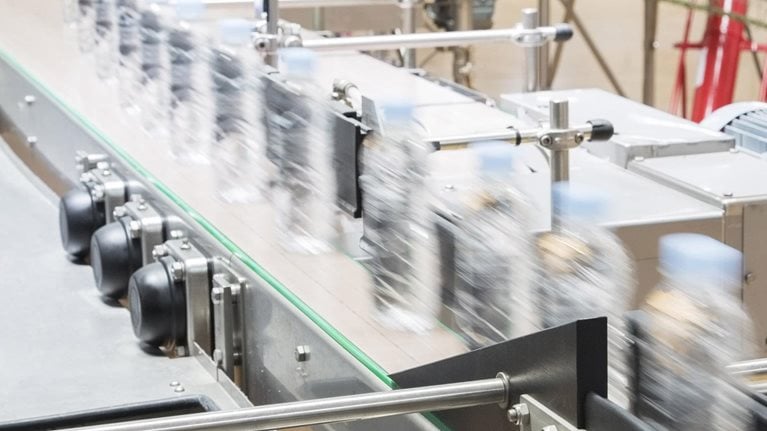The food processing and handling (FP&H) equipment sector provides the systems, machinery, and equipment that help the food industry feed a global population approaching eight billion people. It is the behind-the-scenes enabler that quietly and efficiently moves food from field to factory and onto the plate. It is also a significant global industry that has been growing rapidly in recent years amid rising demand in emerging markets, changes in consumer lifestyles, and a transformative leap forward in technological capabilities.
Stay current on your favorite topics
Comprising three core subsectors—processing, packaging, and commercial food service equipment—FP&H represents a market of roughly $100 billion and has outperformed the broader industrials1 segment over the past five years. By any economic or financial metric—top-line growth, economic profit per dollar of revenue, total return to shareholders, or EBITA margins—our analysis shows the FP&H equipment sector leading the industrials group.
This article assesses the FP&H sector’s historical performance, the shifting dynamics affecting its outlook, and the elements required for companies to capture upcoming opportunities.
Historical performance
In the past five years, the FP&H equipment sector has generated 2.6 percentage points of average annual economic profit (EP/R), compared with 1.5 percentage points for industrials overall. This performance marks a turnaround from the 2002 to 2010 period, when the sector largely trailed industrials overall (Exhibit 1).

Of the 13 sectors that make up the industrials group, FP&H is showing a remarkable resurgence. While it was the second-worst performing on an EP/R basis (EP/R of –0.6 percent) during the 2002 to 2007 period, in the past five years, its 2.6 percent EP/R catapulted the sector to fifth—a jump of seven spots in the ranking, the biggest improvement in relative performance.
The performance improvements can be attributed to four key factors:
- Margin expansion: 470-basis-point improvement in EBITA margin (from 5.5 percent in 2002–07 to 10.2 percent in 2011–16).
- More efficient use of capital: 2.7x capital turns from 2011–16, compared with 2.0x among industrials.
- Return to revenue growth after the financial crisis: 4.3 percent revenue growth (CAGR) from 2011–16, compared with 0.6 percent among wider industrials.
- Resurgence of M&A: 12 transactions on average per year over the past three years, in line with 2006–08 levels.
The ability to generate significant profit improvements during recent economic upcycles is reflected in shareholder returns—FP&H TRS over 2011–16 was 24.7 percent, much higher than the industrials average of 11.4 percent.
However, company performance within the sector has varied widely, and not all companies have performed well. In 2016, some 25 percent of companies generated around 60 percent of economic profit, despite having a 32 percent market share. Put another way, the top quartile of companies created 4.5 times as much EP per company as the average of the rest.
Future outlook
Amid demographic changes, innovation, and evolving customer needs, the outlook for the sector is positive, and growth is expected to accelerate in the years ahead (5 percent CAGR from 2016–21, compared with 4 percent from 2011–16).
As we look to the future, four powerful trends will create tailwinds for the sector and drive this acceleration of growth:
- Emerging market growth, urbanization, and rising living standards. Steady growth in emerging markets, urbanization, and rising living standards are causing a dietary shift to higher-value-added product, fueling demand for processed and packaged foods and leading to higher equipment sales. Emerging markets are driving most of this growth, with Asia expected to contribute about half of global growth between 2017 and 2021.
- Changing consumer preferences. An increasing focus on health (organic and healthier food) is driving product and menu expansion and the need for higher standards and traceability. There will likely be a new range of equipment for food production, requirements for higher machine standards, and a need for specialized systems (for example, radio-frequency-identification labeling) to ensure traceability and minimize spoilage.
- Increased demand for convenience food. Increased demand for convenient “on-the-go” food presents a growth opportunity for the food service subsector—particularly in emerging markets—and is driving innovation in flexible packaging.
- Operational challenges and cost pressures. Customers are demanding machines that improve operational efficiency, reduce costs, and increase uptimes, leading to new requirements for automation, energy efficiency, and integrated solutions. These trends have significant implications for the sector. Rapid growth in emerging markets will lead to accelerating demand for higher-value-added foods that cater to local tastes and needs—requiring specialized machinery for processing, packaging, and service equipment.
An increased focus on food safety and regulation means companies will be required to help track or trace food throughout the value chain, with automation continuing to drive improvements in food safety. (For more on what’s shaping the sector, see the video “Trends driving market growth.”)
Food manufacturers will continue to rely on food processing and packaging-equipment companies to drive innovation for changing tastes and “on-the-go” convenience requirements.
Finally, customers will increasingly rely on equipment manufacturers to provide technologically driven operational efficiencies to improve yields, minimize energy and footprint requirements, and/or reduce labor costs through automation. They will demand more full-solution offerings that are integrated into production management systems and that leverage data to drive performance improvements. (For more on the impact of automation, see the video “How will automation shape the industry?”)
Enablers of success
Executives in the FP&H equipment sector are optimistic about the future, with 65 percent thinking the sector will grow faster than GDP, according to the McKinsey FP&H Equipment Executive Sentiment survey.
Despite these tailwinds for the sector, companies realize that the traditional playbook is becoming outdated, and that to capture growth and deliver breakthrough performance they will need to operate differently.
Based on the same survey, more than 90 percent believe that they will need new capabilities (for example, advanced data and analytics, robotics, and automation and software capabilities), new offerings (such as smarter products and full solutions built around them) and new operating models (for instance, enhanced after-sales and growth-focused strategies).
New capabilities
To adapt to technological advances and a changing environment, companies must have the right capabilities to compete. For example, companies must develop the tools and skills to capture, store, and analyze increasing amounts of data so that they can leverage advanced analytics to make better-informed business decisions.
Advanced analytics can add value across the business, from revenue management (determining which markets to invest in) to deciding how to compete (identifying the right products, channels, and offerings). To bridge the gap between analysis and execution, the ability to integrate analytics into key business processes will be paramount to improving decision making. In parallel, companies will need to invest in data and analytics architecture and tools that enable that integration. This investment includes distributed storage, and computing and data-visualization tools that are plugged into existing workflow tools and that provide actionable insights.
Would you like to learn more about our Advanced Electronics Practice?
As an example of analytics applications in action, Welbilt has leveraged software to power its “kitchen connect” remote monitoring solution, offering comprehensive in-field support and functions to streamline operations such as menu management, alerts, and maintenance. These analytics offer insights into operating models and equipment, from refrigeration to lighting and ventilation. Marel Innova, meanwhile, uses analytics to provide full production control for food processing plants, monitoring activities through the value chain and including dashboards to give executives a picture of key performance indicators such as device and process performance, weighting and labeling, logistics, and traceability.
Companies should seek to hardwire their analytics capabilities so that they can modularize expansion as the business moves forward. This way, they can add capabilities as a natural element of new products and services and continuously work to improve data harvesting and applications. Over time, data and analytics can become a key strategic asset, offering FP&H equipment companies new business propositions and a sharp cutting edge.
New offerings
Advances in technology are creating opportunities to expand beyond hardware and offer smarter solutions that drive significant value. As smarter products offer differentiation and margin opportunities, companies can extend their ambition toward more innovative, “up-the-stack,” and customized products and services that fully leverage the capabilities of today’s technology.
Examples of new offerings include the following:
- Embedded sensors and connected devices using cellular or Wi-Fi connectivity to transmit and analyze data in real time, collecting data and providing remote access to facilities.
- Cloud-enabled products with software solutions created, deployed, and operated on cloud-based platforms, offering continuous data acquisition via platform-as-a-service for developing, deploying, operating, and monetizing industrial internet applications.
- Embedded software-enabled products representing the full suite of solutions that can be used to glean insights, increase efficiencies, and enable new products and services.
In addition to creating smarter products, companies can extend product ranges by developing full-solution offerings (to include installation, monitoring, services, and integration, as well as broader production management systems). Taking that strategic step requires a more consultative, collaborative development process and an efficient sales funnel. A first step is to identify and prioritize high-growth opportunities through systematic analysis of customer pain points and a strategic focus on creating more tailored solutions. Successful iterations may be supported by efficient coverage, incentives, support, and performance management to drive sales force effectiveness, as well as seamless collaboration between sales and operations in implementation.
New operating models
As companies migrate from a product to a service focus, they must take the necessary steps to renew their operating models to align with reimagined businesses. (For more on the impact of digital in the sector, see the video “Driving performance via digital transformation.”) Looking to the future, let’s consider two examples of these activities:
Developing innovative after-sales service models. After-sales make up a significant and highly profitable segment of FP&H equipment companies’ revenue. After-sales typically account for about 25 percent of a company’s revenue, but typically have gross margins that are two times higher than other revenue sources. This, coupled with the recurring nature of after-sales revenue, means getting after-sales right can lead to a meaningful uptick in profitability.
Companies seeking to increase their focus on after-sales may, as a first step, develop tools to map and monitor aftermarket lifetime value. This effort should include creating a detailed schematic of the installed base and establishing and measuring key performance indicators (such as the attach rate for a particular product) supported by enhanced back-office capabilities. By highlighting average annual penetration per customer against target annual penetration, for example, the schematic can show where the company is underpenetrated or not achieving its “fair share” of revenues. This strategy should be accompanied by careful planning (and monitoring) and a strict focus on execution and growth.
Aligning with new market growth. New market growth provides a significant opportunity. Geographic expansion is a compelling possibility for the FP&H equipment sector. Over the past ten years, FP&H equipment companies that have increased their emerging market presence have returned 7 percent more shareholder value than those that have not.
Companies will require defined growth and go-to-market strategies to target new markets, whether through partnerships, M&A, or organic growth. The FP&H equipment space is complex, consisting of many niche areas or micromarkets, each of which has its own unique characteristics and players. Developing a detailed understanding of the value chain and different steps in the chain is important to identifying areas for growth.
Progress in developing enablers
Although executives recognize the need to enhance the traditional playbook, a significant gap remains between cognition and implementation. According to the same survey, limited progress has been made to date, with only 7 to 27 percent of FP&H equipment companies having made significant progress in building the right enablers (offerings, capabilities, and operating model) to capture the value from this growth (Exhibit 2).

What is required to win
The tailwinds driving the FP&H equipment sector will provide ample opportunity for companies equipped with the right enablers to outperform their peers and the overall sector. However, many companies try too hard to maintain the status quo and are left behind as markets change. As outlined in a Chris Bradley, Martin Hirt, and Sven Smit article from the McKinsey Quarterly, “Have you tested your strategy lately?,” the cost of delay is steep, and those who wait too long are often too late to develop a strategically effective response. Companies that use the old playbook for success can be left behind as innovation disrupts the sector. Conversely, companies that get ahead of the curve can use major market transitions in their favor to tailor their strategies to a new environment. Going forward, we believe that companies must address three key questions to develop a winning strategy, get going, and scale up: where to play, how to play, and when to play (Exhibit 3).

Where to play
In developing a strategy to outperform the market, companies must first decide which markets to compete in (Exhibit 4). The unit of analysis used in determining strategy (that is, the degree to which the market is segmented) significantly influences resource allocation and thus the likelihood of success. Indeed, the Bradley, Hirt, and Smit article finds that markets should be segmented as narrowly as possible, within reason: “think 30 to 50 segments rather than the more typical 5 or so.”

The FP&H equipment sector encompasses a multitude of micromarkets, each with its own intricacies and interdependencies. For example, the food packaging equipment market can be analyzed on a geographical basis and by product segment, process steps, and materials used. Growth rates, competitors, customers, and risks need to be considered for each segment of the micromarket. Once companies have determined how to segment their market, they must identify which are the most attractive segments, and why. A combination of factors—size, growth, and profitability—determines attractiveness. Additionally, within each micromarket, companies should seek to understand how much value is being created and the drivers of that value, including customer and competitor behaviors. Profit pool analysis can inform decision making and help companies orient their planning toward specific activities, segments, and geographies.

How industrial companies can respond to disruptive forces
Finally, companies must understand how the specific micromarkets that are most attractive fit with the company’s capabilities, technology road map, and risk profile. For example, an FP&H equipment company in the primary processing space could consider expansion by integrating along the value chain into secondary processing equipment for similar protein types, or by leveraging its technology for applications across other proteins. When deciding whether a micromarket is the right fit and a feasible target, a company must consider two elements. First, it needs to look at its ability to produce the relevant technology that will fill a gap and differentiate the company in that specific market, and second, at its strength and ability to execute in that market—that is, whether the company has the right infrastructure, capabilities, and business model for that market.
Understanding the dynamics, characteristics and subsequent potential in each of these micromarkets—while also grasping how these micromarkets fit with a company’s respective strengths—is essential for companies to address where they want (and are most able) to play. Indeed, defining and understanding segments correctly is one of the most practical things a company can do to improve its strategy.
How to play
After deciding which markets to prioritize, companies need to develop a robust understanding of how to play in these markets. Depending on the nature of the prioritized markets, following the traditional playbook may not be enough to be successful.
As noted earlier, winning in these markets may require a different set of products and solutions (such as connected or cloud-enabled products), new capabilities (for example, software and solutions capabilities or advanced analytics capabilities), and new operating models and organization (for instance, new go-to market approaches). In the FP&H equipment space, for example, the shift toward solution selling is requiring sales forces to adapt. Companies are increasingly required to develop more technically proficient salespeople who can convey the value from total cost of ownership.
Once the playbook required to win is clearer, companies often must choose how to address any gaps in this playbook—whether to do it organically or to pursue partnerships or acquisitions. M&A can accelerate a variety of strategies that are too expensive, time sensitive, or competitively critical to rely on an organic approach. Some examples include pursuing growth in adjacencies without access to customers or distribution, a strong brand name in a specific niche, or the talent and capabilities to develop machine-learning algorithms.
When to play
Strategy is not just about where and how to play, but also when to play. Once a company has figured out which micromarkets to enter and created its playbook for developing a differentiated offering in those markets, the company must strategically time and sequence its investments in new areas. Committing too early can be a leap into the unknown; instead, companies can make small investments by running a pilot that targets select customers in a new market and then using the findings from that pilot to scale up offerings. This effort requires a company to have clear metrics and processes for tracking the signals from its investments so that it can move quickly to scale. Conversely, being too late is also dangerous because opportunities can expire, or rivals can seize advantage while a company stands on the sidelines. If companies choose to take a fast-follower approach, they must be able to monitor market developments so as not to be left with an insurmountable challenge.
The FP&H equipment sector has seen rapid growth in recent years. This growth is set to continue amid rising demand from emerging markets, changing consumer preferences, and the drive toward automation due to operational and cost pressures. The future is bright, and executives are optimistic that the sector will outpace broader economic growth in the years ahead. However, the sector is in danger of resting on its laurels. Action is required to turn potential into reality.
Industry executives understand that a new playbook is needed. Companies must embrace technology and robustly engage with the dynamics shaping the sector and the changing demands of the global market. Companies require new capabilities, new and smarter products, and in some cases reimagined operating models that focus on established and potential areas of growth.
Of course, no company can be all things to all people. Incumbents must now assess their current position and identify the right strategy to take the business forward. Based on microsegment profit pool analysis, they must decide where to play; then they must decide how to play—which products, capabilities, partnerships, and value-capture strategies will make them successful in these microsegments.
Finally, once a company has figured out which micromarkets to enter and created its playbook for developing a differentiated offering in those markets, the company must decide when to play, and strategically time and sequence its investments in new areas.
Download McKinsey on Food Processing & Handling: Ripe for Disruption?, the full publication from which this article excerpted (PDF—5.2MB).


